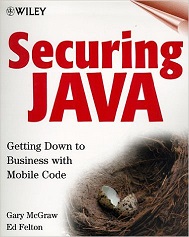
|
FreeComputerBooks.com
Links to Free Computer, Mathematics, Technical Books all over the World
|
|
- Title: Securing Java: Getting Down to Business with Mobile Code
- Author(s) Gary McGraw, Edward W. Felten
- Publisher: Wiley; 2 edition (January 25, 1999)
- Paperback: 324 pages
- eBook: HTML and PDF
- Language: English
- ISBN-10: 047131952X
- ISBN-13: 978-0471319528
- Share This:

|
As Java matures and moves into the enterprise, security takes a more prominent role. But as Java evolves, its security issues and architectures get more complicated. Written by the world's leading experts on mobile code security, this updated and expanded edition of the groundbreaking guide to Java security includes lessons for Web users, developers, system administrators, and business decision-makers alike.
This book navigates the uncharted waters of mobile code security and arms the reader with the knowledge required for securing Java. It provides in-depth coverage of:
- The base Java security sandbox, made up of the Verifier, Class Loaders, and the Security Manager
- Code signing, stack inspection, and the new Java 2 security architecture
- The pros and cons of language-based enforcement models and trust models
- All known Java security holes and the attack applets that exploit them
- Techniques commonly used in malicious applets
- Twelve rules for developing more secure Java code, with explicit examples
- Hard questions to ask third-party Java security tools vendors
- Analysis of competing systems for mobile code, including ActiveX and JavaScript
- Card Java security, smart card risks, and their impact on e-commerce security
- N/A
- Java Security
- Enterprise Java (Java EE, Persistence, Web Services, Messaging, Spring, etc.)
- Java Web Frameworks, MVC - Srtuts, JSF, Spring MVC, etc
- Java Build and Testing

- Securing Java: Getting Down to Business with Mobile Code (Gary McGraw, et al.)
- The Mirror Site (1) - PDF
-
 Pairing Apache Shiro and Java EE 7 (Nebrass Lamouchi)
Pairing Apache Shiro and Java EE 7 (Nebrass Lamouchi)
Learn how to use Apache Shiro in a JavaEE7 application and how to use it in a web application. This book will help you find out what Shiro actually is, and will help you to secure your Java EE project from scratch and to understand the security philosophy.
-
 Java Authentication and Authorization Service (JAAS) in Action
Java Authentication and Authorization Service (JAAS) in Action
By the end of this book, you will both understand and use the functionality in JAAS, and also be able to replace many of the pieces provided by the JDK or whatever application server you may be using with your own custom classes.
-
 Practical Guide to Building an API Back End with Spring Boot
Practical Guide to Building an API Back End with Spring Boot
Starting your first project with Spring Boot can be a bit daunting given the vast options that it provides. This book will guide you step by step along the way to be a Spring Boot hero in no time.
-
 Java 2 Network Security (Marco Pistoia, et al)
Java 2 Network Security (Marco Pistoia, et al)
This book provides the complete insiders guide to securing Java 2 enterprise applications, with comprehensive coverage of the new Java 2 security models. Designed to help you integrate Java 2 into your enterprise security strategies.
-
 O'Reilly® Java Security (Scott Oaks)
O'Reilly® Java Security (Scott Oaks)
This book provides the Java programmer with a complete overview of the Java security architecture and security classes, plus a wealth of detailed information and code examples for specific implementations.
-
 UNIX System Security: A Guide for Users & System Administrators
UNIX System Security: A Guide for Users & System Administrators
This book begins by examining four high-profile breaches of UNIX security as illustrations of how a UNIX system can be attacked. It then provides the information necessary to protect against these forms of attack, and offers the tools.
-
 Security of Ubiquitous Computing Systems (Gildas Avoine, et al)
Security of Ubiquitous Computing Systems (Gildas Avoine, et al)
It is to improve and adapt existent cryptanalysis methodologies and tools to the ubiquitous computing framework that lies along four axes: cryptographic models, cryptanalysis of building blocks, security engineering, and security assessment.
-
 Security Engineering: Building Dependable Distributed Systems
Security Engineering: Building Dependable Distributed Systems
It makes it clear just how difficult it is to protect information systems from corruption, eavesdropping, unauthorized use, and general malice, offers a lot of thoughts on how information can be made more secure by both technologies and strategies.





